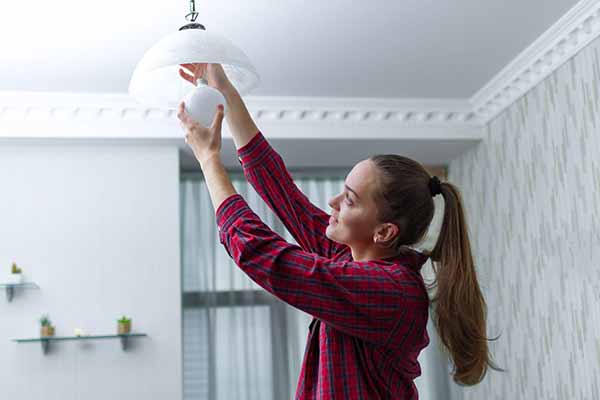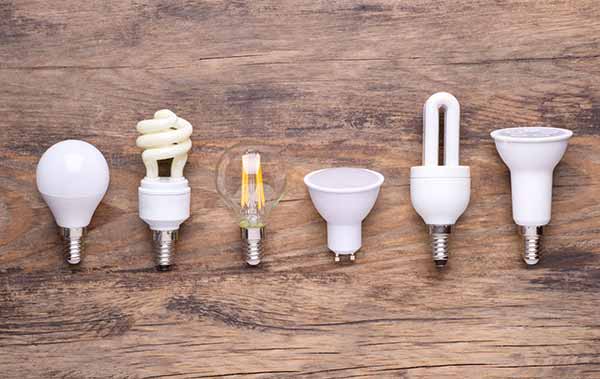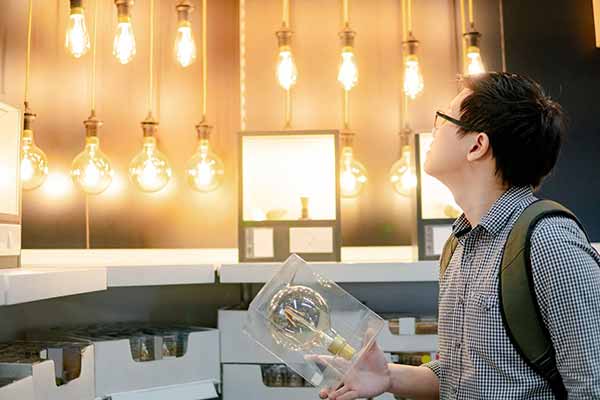Energy-efficient lighting choices abound these days, whether online or at your local hardware store. They range from simple, ordinary light bulbs to fancy, antique-style, decorative light bulbs that come in varying shades from white to amber.
There was a time in the not-so-distant past that most of us didn’t really think about light bulbs. You may remember that item on the grocery list – it just said, “light bulbs.”
For much of the 20th century, the incandescent light bulb dominated the scene. The only real differences were brand, wattage, and color temperature. Energy efficiency wasn’t something many people thought about, and though the more energy-efficient CFL bulbs were invented in 1976, they were too expensive to produce for household use.
Regardless of whether you’re selecting your lighting based on the color temperature of your bulb (ranging from bright white to warm), the kind of light fixture in your home, or level of brightness (lumens), use this lighting guide to help you find the right bulb for every fixture in your home.
Can Energy-Efficient Light Bulbs Save on Energy Costs?
Here’s an enlightening fact: In the United States, residential lighting accounted for about 4% of household electricity consumption in 2020. That might not seem like a lot at first glance, but it translates into 62 billion kilowatt hours (kWh) – that’s a lot of energy! Further, lighting for commercial and institutional buildings and public places consumed approximately 157 billion kWh for lighting, which was about 12% of total commercial sector electricity consumption and about 4% of total U.S. electricity consumption.
Pro tip: Get to know more about kilowatts and calculations.
The potential to cut energy costs by reducing electricity used for lighting is significant. Replacing your old lighting with newer, more energy-efficient alternatives is a great place to start.
There are numerous lighting options available on the market, including Energy Star–certified products. When you choose energy-efficient light bulbs, you not only increase energy efficiency in your home or office (thereby doing your part to conserve energy for the planet), but you also save money. That’s because the lifespan of these newer bulbs is often longer, and their lower energy consumption reduces your electric bill.
What Is a Lumen? How Does It Relate to Watts and Affect Energy Savings?
Essentially, watts measure energy use, and lumens measure brightness, or the amount of light you get from the bulb.
Back in the day, when your grocery list simply said “get light bulbs,” you probably would’ve grabbed the first 60-watt or 100-watt light bulb you saw, depending on the light output you needed.
Light bulb technology is far more advanced nowadays, resulting in an abundance of information on light bulb packages. For example, on an LED incandescent replacement bulb, you may find the following specifications on the packaging:
- Luminous flux: This refers to the number of lumens or how bright the light bulb will be.
- Watts: Wattage tells us how much electricity the light bulb will use.
- Incandescent equivalent: Incandescent replacement bulbs will often show how the light bulb compares to standard incandescent bulbs when it comes to wattage usage. For example, the package may say, “40 watt light bulb replacement. Uses only 6 watts.”
- Color: Light bulb color can range from bright white to warm white or even amber.
- Color temperature: This is represented by the number of kelvins (K) and shows how the color temperature matches the color of existing incandescent bulbs. For example, a warm white may say “2,700 kelvins.” Color temperatures range from warm to cool, with 1,000 kelvins being the warmest (nearing amber) and 10,000 kelvins being the coolest (bright white).
- Average life: This is an estimate of how long the bulb is expected to last.
- Base type: A standard base is e26 in the United States, which means it fits into a standard light bulb socket.
Newer light bulbs also give us a lot more bang for our buck: Better lighting technology produces a light bulb that can use fewer watts to give off more light. The result is that today’s light bulbs are far more energy-efficient.
For example, a 100-watt equivalent LED incandescent replacement bulb might only use 14.5 watts of electricity and emit a “daylight” output of 1,450 lumens at a temperature of 2,700 kelvins. Or a substitute for a standard 60-watt equivalent incandescent lamp may use just 10 watts and put out a bright light of 750 lumens.
With newer technology, we also have more decorative choices ranging from soft white light to cool white, warm white, or amber. There are also dimmable light bulbs, frosted bulbs, or new-tech light bulbs that look vintage even though they are energy-saving LEDs. With LED bulbs, you no longer have to disrupt your interior design and compromise energy savings or money savings.
Energy Efficient Lighting Comparisons: CFL, LED, Halogen, and Incandescent Bulb
When it comes to lighting selections, consumers now have three major types of bulbs to choose from: new and improved incandescent light bulbs that use 28% less energy, compact fluorescent lamps (CFLs), and light-emitting diodes (LEDs) that offer 75% or more energy savings above incandescent bulbs. Even better? They also last a lot longer.
Want an apples-to-apples comparison of light bulbs that are available on the market? Check out this comparison chart by Earth Easy. Though it is highly comprehensive, it can’t account for different energy rates in other world areas. Still, it can give you a side-by-side look at the lighting choices you have on the market.
LED Light Bulbs
Light-emitting diode (LED) light bulbs have come a long way in recent years, making them the most cost-effective and energy-efficient lighting choice on the market. Among other things, LEDs last longer (about 30 times longer than incandescent bulbs and 3-5 times more than CFLs). They also run at a cooler temperature than other types of light bulbs, and as stated earlier, they use less energy.
It’s expected that most lighting will use LED technology by 2035, leading to significant energy savings – more than 569 Terawatt-hours (TWh) per year, comparable to the yearly output of energy by nearly a hundred 1,000-megawatt (MW) power plants.
Compact Fluorescent Light (CFL)
CFL light bulbs are fluorescent lamps that are usually intended as a replacement for less efficient halogen lamps or incandescent bulbs. They come in two setting types: screw-in and plugin.
The screw-in CFL bulb is self-ballasted and can usually be used in a regular light socket with no adapters or other necessary equipment. However, plugin CFL bulbs need a ballast, and they require a corresponding socket that fits their base specification.
CFL lamps come in an array of sizes, color temperatures, and wattages. CFLs are low-cost and last longer than incandescent light bulbs. Also, though not as efficient as LEDs, CFLs became popular because of their efficiency and easy availability.
Enter your ZIP Code and compare electricity rates
Halogen Lamps
Halogen lamps are a bit more efficient than incandescent light bulbs, but they are hot. In fact, the operating temperatures can create safety hazards with some types of light fixtures – a torchiere fixture is an excellent example of this.
A halogen bulb is almost as bright as an LED (putting out high lumens), but it uses about nearly four times the watts that a LED requires.
Standard Incandescent Blubs
The least efficient light bulb on the market, the incandescent lamp is an electric light bulb that functions by incandescence, which means that the emission of light is caused by heating the filament inside the bulb. They are made in an extensive range of sizes, wattages, and voltages.
Incandescent bulbs were the first electric lighting available, and they have been in use for over 100 years. Though Thomas Edison is widely considered the inventor of the incandescent bulb, several people invented components and prototypes of the light bulb long before Edison did.
Incandescent bulbs are scheduled to be phased out, though there has been a lengthy legal saga surrounding this, and it’s not over yet.
What Do the Lighting Standards Mandate By EISA 2007 Mean to Consumers?
In 2007, the United States Congress passed the bipartisan Energy Independence and Security Act (EISA). The EISA established opening efficiency standards for light bulbs.
EISA stipulated that the Department of Energy (DOE) should decide if tighter efficiency standards for light bulbs were necessary. If so, they were to collaborate with industry leaders and the general public to develop new “rules.” Rulemaking is the policy-making process that results in new government regulations.
The Department of Energy (DOE) put forth an efficiency standard for General Service Lamps (light bulbs). New lighting standards were phased in from 2012 to 2014 but didn’t ban any specific bulb type, such as standard incandescent light bulbs.
The Obama administration made strides in furthering the efficiency rules to more kinds of light bulbs. However, under pressure from the National Electric Manufacturers Association (NEMA), the Trump administration rolled back those efforts in 2017.
Today, DOE is proposing a new lighting standard that would apply to all light bulbs, including LED and compact fluorescent lights. This could mean that less efficient incandescent bulbs will no longer be available on the market.
When It Comes to Energy Savings, Which Light Bulbs Are Best?
With so many lighting choices out there, it may feel a little overwhelming when trying to select the most energy-efficient light bulbs for your needs.
Generally, the most energy-efficient lighting technology you can buy for your home is the Light Emitting Diode (LED). A quality LED produces the most light with the least amount of electricity.
According to the Consumer Energy Alliance, Energy Star-certified LED light bulbs are 90% more efficient than standard light bulbs and 80% better than fluorescent bulbs.
What Are “New Light Bulbs” and Why Do They Exist?
Lighting choices are quickly changing. New lighting technologies are making light bulbs more efficient, more affordable, and longer-lasting and giving out more lumens for fewer watts. That’s excellent news for the environment and for your pocketbook!
It’s hard to say when these new bulbs will be phased in and less efficient lamps phased out as it has been in the works since the EISA 2007 mandate.
However, as it becomes more evident every year that global warming is a significant threat to humanity, more vigorous efforts are being made at sustainability, including creating solid regulations around light bulbs and their energy efficiency.
Traditional incandescent bulbs have served us well for over 100 years. Still, they are costly to use and inefficient compared to the new lighting technology that is continually evolving and improving.
Energy-Efficient Lighting Choices Mean Energy Savings and Lower Energy Bills
As technology improves, so does energy savings along with the bottom line cost on your electricity bills.
Even though less efficient incandescent light bulbs are still available on the market, it’s essential to do your part for sustainability. Fortunately, energy conservation is cost-effective and easy to do now that more energy-efficient lighting choices are widely available.
Brought to you by energysavings.com
All images licensed from Adobe Stock.
Featured image:



